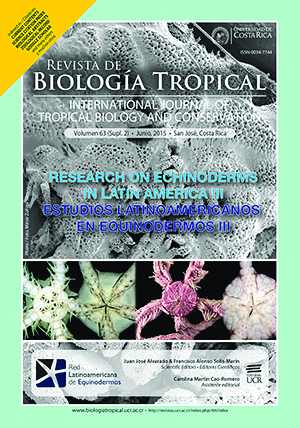Abstract
The post-metamorphic stage is essential in the life history of marine invertebrates. During this period, animals are more vulnerable and suffer high mortality, which influences the distribution and abundance of adult populations. It is also during this period that major morphological changes happen in the individuals, complicating their taxonomic identification. The juvenile ophiuroids dominate the meiofauna in certain times of the year and at some places. However, they are ignored by most ecological studies due to identification difficulties. Here we describe the ontogeny of nine deep-sea species from the Southeast and South regions of Brazil, with the first record of morphological modifications for eight of them. Most organisms were collected 60 to 800 m deep, between December 1997, January, 1998 and March, 1998, during the REVIZEE-Score South / Benthos program. We also included additional material from the Zoology Museum of Unicamp (ZUEC). For descriptions and identifications of the different stages, the specimens were dried and photographed. The juveniles were identified by “backwards” process through the growth series of adults to smaller individuals, a backwards method that was successful in previous studies. Some individuals were mounted on aluminum stubs for scanning electron microscopy. The species were: Ophiacantha pentacrinus (Ophiacanthidae), Ophiomastus satelitae, Ophiomusium acuferum, Ophiomusium eburneum, Ophiomisidium tommasii, Ophiura ljungmani, Ophiura clemens (Ophiuridae), Amphiura complanata (Amphiuridae) and Ophiothrix rathbuni (Ophiotrichidae). Many species could be identified since their most juvenile stage. Some structures remain almost unaltered during the whole life.
References
Bartsch, I. (1985). Astrotoma agassizii Lyman, 1875 (Gorgonocephalidae, Ophiuroidea), Beschreibung der Skelettplatten der Adulten und Juvenilen. Mitteilungen aus dem Hamburgischen Zoologischen Museum und Institut, 82, 303-309.
Clark, H. L. (1914). Growth changes in brittle stars. Publications of the Carnegie Institution, 5, 93-126.
Fell, H. B. (1946). The embryology of the viviparous ophiuroid Amphipholis squamata (D.Ch.). Transactions of the Royal Society of New Zealand, 75, 419-464.
Gage, J. D. (1984). On the status of the deep-sea echinoids, Echinosigra phiale and E. paradoxa. Journal of the Marine Biological Association of the United Kingdom, 64, 157-170
Gage, J. D., & Tyler, P. A. (1982). Growth and reproduction of the deep-sea brittlestar Ophiomusium lymani Wyville Thomson. Oceanologica Acta, 5, 73-83.
Hendler, G. (1978). Development of Amphioplus abditus (Verrill) (Echinodermata: Ophiuroidea). II. Description and discussion of ophiuroid skeletal ontogenies and homologies. Biological Bulletin, 154, 79-95.
Hendler, G. (1988). Ophiuroid skeleton ontogeny reveals homologies among skeletal plates of adults: a study of Amphiura filiformis, Amphiura stimpsonii and Ophiophragmus filograneus (Echinodermata). Biological Bulletin, 174, 20-29.
Lampitt, R. S., Sumida, P. G., & Pérez-Castillo, F. (2002). Ophiuroid growth with deep-sea sediment traps: A problem for carbon flux measurements at continental margins. Limnology and Oceanography, 47, 571-575.
Monteiro, A. G. (1987). Ophiuroidea (Echinodermata) da região de Ubatuba (SP)-aspectos morfológicos e ecológicos (Doctoral thesis). Universidade de São Paulo.
Monteiro, A. G., Reis, M. O., & Pardo, E. V. (1992). Morfologia comparativa e distribuição batimétrica de duas espécies de Ophiuoidea na região costeira de Ubatuba. Boletim do Instituto Oceanográfico, 40, 39-53.
Schoener, A. (1967). Post-larval development of five deep-sea ophiuroids. Deep-Sea Research, 14, 645-660.
Schoener, A. (1969). Atlantic ophiuroids: some post-larval forms. Deep-Sea Research, 16, 127-140.
Stöhr, S. (2005). Who’s who among baby brittle stars (Echinodermata: Ophiuroidea). Zoological Journal of the Linnean Society, 143, 543-576.
Stöhr, S. (2012). Ophiuroid (Echinodermata) systematics - where do we come from, where do we stand and where should we go? Zoosymposia, 7, 147-161.
Sumida, P. G., Tyler, P. A., Lampitt, R. S., & Gage, J. D. (2000). Reproduction, dispersal and settlement of the bathyal ophiuroid Ophiocten gracilis in the NE Atlantic Ocean. Marine Biology, 137, 623-630.
Sumida, P. Y., Tyler, P. A., Gage, J. D., & Nørrevang, A. (1998). Postlarval development in shallow and deep-sea ophiuroids (Echinodermata: Ophiuroidea) of the NE Altantic Ocean. Zoological Journal of the Linnean Society, 124, 267-300.
Tommasi, L. R. (1970). Os ofiuróides recentes do Brasil e de regiões vizinhas. Contribuições Avulsas do Instituto Oceanográfico, 20, 1-146.
Turner, R. L., & Miller, J. E. (1988). Post-metamorphic recruitment and morphology of two sympatric brittlestars. In R. D. Burke, P. V. Mladenov, P. Lambert, & R. L. Parsley, (Eds.), Echinoderm biology (pp. 493-502). Rotterdam: Balkema.
Tyler, P. A., Gage, J. D., & Billett, D. S. (1991). Reproduction and recruitment in deep-sea invertebrate populations in the NE Altantic Ocean: a review of the options. In G. Colombo, I. Ferrari, V. U. Ceccherelli, & R. Rossi. (Eds.), Marine eutrophication and population dynamics (pp. 257-262). Denmark: Olsen & Olsen.
Webb, C. M., & Tyler, P. A. (1985). Post-larval development of the common north-west European brittle stars Ophiura ophiura, O. albida and Acrocnida brachiata (Echinodermata: Ophiuroidea). Marine Biology, 89, 281-292.
##plugins.facebook.comentarios##

This work is licensed under a Creative Commons Attribution 4.0 International License.
Copyright (c) 2015 Revista de Biología Tropical


